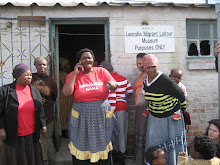In the light of this Hostel 33’s bucket system area, is hugely significant in telling the stories of living conditions prior to the housing project. Image 2 shows the state of the structure prior to cleaning out, more than ten years since it was last used.

Image 1: Lwandle aerial. Photograph: Andrew Bermann 1987



Image 2a: The derelict state of the bucket system before clearing. Photograph: Alan Middleton (Jakupa Architects), 2010, Draft Condition Report, photograph taken December 2009


Image 2b showing where new untits were added onto the ends of hostel bocks to increase the number of units and how the bucket system areas were removed from the ends of buildings, leaving the structure at Hostel 33 as the only remianing structure. Photograph: Noeleen Murray 22 April 2010.
Section 2.24 of the 1987 Report entitled ‘Exiting Conditions and Residents Problems’ cites a meeting with the Hostel and Women’s Committees in which a range of problems were communicated to the group which attended the meeting. (See Image 3 and 'Lwandle in the 1980s' on this blog). First among these was point a:
‘a) dissatisfaction with the bucket toilet system: Night soil is removed only 3 times a week. However the day after removal the buckets are already full of excrement, remaining there till the next day and in the case of weekends, for 2 days. The outside toilets are also far from the hostel rooms.’
Image 3 from the Report shows what a typical cubicle looked like, and Image 4, shows cubicle #5 at Hostel 33 which is the only cubicle containing a remnant of a timber toilet seats. From this evidence, cross checked with and careful measurements on site, Renchius prepared drawings of the seats – See Images 5 and 6. Samples of the timber remnant were carefully removed from the underside of the old seat and this revealed a fine grained hardwood, probably Clear Oregon Pine or Baltic Deal (views from William Martinson and Renchius van der Merwe). It was suggested that the samples be sent for testing.
Section 2.24 of the 1987 Report entitled ‘Exiting Conditions and Residents Problems’ cites a meeting with the Hostel and Women’s Committees in which a range of problems were communicated to the group which attended the meeting. (See Image 3 and 'Lwandle in the 1980s' on this blog). First among these was point a:
‘a) dissatisfaction with the bucket toilet system: Night soil is removed only 3 times a week. However the day after removal the buckets are already full of excrement, remaining there till the next day and in the case of weekends, for 2 days. The outside toilets are also far from the hostel rooms.’
Image 3 from the Report shows what a typical cubicle looked like, and Image 4, shows cubicle #5 at Hostel 33 which is the only cubicle containing a remnant of a timber toilet seats. From this evidence, cross checked with and careful measurements on site, Renchius prepared drawings of the seats – See Images 5 and 6. Samples of the timber remnant were carefully removed from the underside of the old seat and this revealed a fine grained hardwood, probably Clear Oregon Pine or Baltic Deal (views from William Martinson and Renchius van der Merwe). It was suggested that the samples be sent for testing.

Image 3: Photograph 5. Caption: ‘A bucket toilet cubicle. The floor is flooded with excrement making use of the system very difficult.’ Source: Urban Design Services (Bermann and Penz), 1987, Lwandle Investigation into the potential for Black Housing, Draft report for the Urban Foundation, February 1987, p.28

Image 4: Toilet cubicle #5 showing remnant of toilet seat. Photograph: Laura Davies March 2010

Image 4: Toilet cubicle #5 showing remnant of toilet seat. Photograph: Laura Davies March 2010









Note new image added to this post, showing the blockwork additions to hostels after the Hostels-to-Homes Project, after which Hostel33's bucket system structre was the only one of its type left in Lwandle.
ReplyDeleteHostels are full of young and young-at-heart backpackers and a few budget businessmen.
ReplyDeletePousada Do Rio Quente